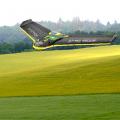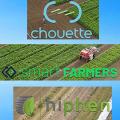Society and regional strategies Reading time 2 min
Arnaud Delaherche, vineyard worker: "Technology has transformed our work"
Published on 16 December 2019

"Château Pape Clément is a 90-hectare farm located in the Bordeaux area. The transition to remote sensing started with the acquisition of a Novadem aerial robot intended to evaluate vine vigour. Vine is a creeper that is capable of growing indefinitely without meeting grape quality expectations. It is therefore produced differently depending on its vigour, which is measurable by the amount of chlorophyll found in the leaves. The original drone also made it possible to create a map of the geo-referenced vine for the first time, which precisely located the best production areas. This process, called surveying, was previously carried out by a surveyor. Now it is only necessary to identify a plot whose rows will then be supervised by an autonomous robot. This change is a small revolution in itself.
The estate’s fleet initially included a drone with a fifteen-minute flying capacity. Two more drones with one hour of autonomy are now in use, and their detection missions have been extended. One of those, of great importance, consists in determining the soil slope gradient. Grapevines do not like water-logging. They needs a certain level of water stress to develop. Stagnant water may accumulate in certain plots, which then has to be drained from the lowest points. The operation is carried out using the information provided by the drone, and allows the vine to grow in a better-adapted soil.
Drone precision has increased thanks to that of their sensors. The latest major innovation, for us, concerns the detection of mildew, developed by the Chouette start-up company (cf. article 5). The drone detects spots on the vine, but it can also observe what the human eye cannot thanks to its infra-red camera, that is to say texture and leaf colour modifications. From there, we can identify the plots that are most affected, and anticipate treatment applications. The objective is to adjust the treatment for each area, and this naturally requires a system to transfer the data collected by the drone to the tractor or straddle tractor, which then doses what the sprayer will inject. Finally, still thanks to the use of detection, it is now possible to estimate the number of missing vine plants in a vineyard, and to easily replace them. Previously we had to wait until the end of the harvest to quantify and replant them.
Margin of error
Detection technology saves us time and money, even if its initial cost remains high and still discourages a number of farmers. But it is clear that their use has changed our profession. Their use forces us to acquire new skills. It is essential to obtain a microlight pilot licence in order to fly a drone. It is also necessary, as I did, to undergo map reading training. Not everyone is at ease with such technology, and I can understand that, for it remains essential to stay in contact with the vineyard.
Technology has not solved everything yet. What we now lack is precise information concerning yields. When we estimate them, we may encounter a 20% margin of error for certain vines. We have no precise idea of their volume at the time of the harvest, and this lack of knowledge is problematic. The drone offers a view from above, and grapes still grow towards the bottom of the plant, hidden by the leaves. Similarly, we still lack information concerning diseases other than mildew, such as vine deficiencies according to its degree of exposure and soil conditions. We need this data in order to improve our practices and thus obtain better yields.
Read the whole report:





